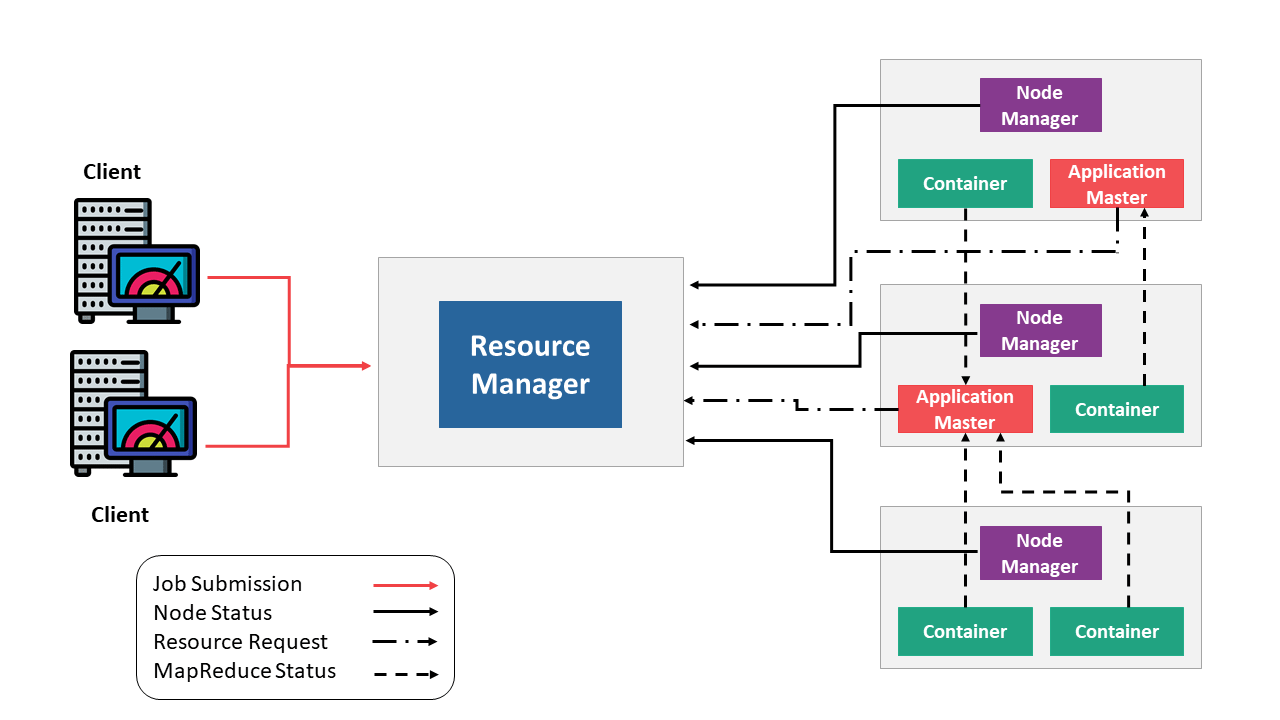Azure Data Engineer Associate Certification C ...
- 2k Enrolled Learners
- Weekend
- Live Class
Hadoop YARN knits the storage unit of Hadoop i.e. HDFS (Hadoop Distributed File System) with the various processing tools. For those of you who are completely new to this topic, YARN stands for “Yet Another Resource Negotiator”. I would also suggest that you go through our Hadoop Tutorial and MapReduce Tutorial before you go ahead with learning Apache Hadoop YARN. I will be explaining the following topics here to make sure that at the end of this blog your understanding of Hadoop YARN is clear.
In Hadoop version 1.0 which is also referred to as MRV1(MapReduce Version 1), MapReduce performed both processing and resource management functions. It consisted of a Job Tracker which was the single master. The Job Tracker allocated the resources, performed scheduling and monitored the processing jobs. It assigned map and reduce tasks on a number of subordinate processes called the Task Trackers. The Task Trackers periodically reported their progress to the Job Tracker.

This design resulted in scalability bottleneck due to a single Job Tracker. IBM mentioned in its article that according to Yahoo!, the practical limits of such a design are reached with a cluster of 5000 nodes and 40,000 tasks running concurrently. Apart from this limitation, the utilization of computational resources is inefficient in MRV1. Also, the Hadoop framework became limited only to MapReduce processing paradigm.
To overcome all these issues, YARN was introduced in Hadoop version 2.0 in the year 2012 by Yahoo and Hortonworks. The basic idea behind YARN is to relieve MapReduce by taking over the responsibility of Resource Management and Job Scheduling. YARN started to give Hadoop the ability to run non-MapReduce jobs within the Hadoop framework.
You can also watch the below video where our Hadoop Certification Training expert is discussing YARN concepts & it’s architecture in detail.
With the introduction of YARN, the Hadoop ecosystem was completely revolutionalized. It became much more flexible, efficient and scalable. When Yahoo went live with YARN in the first quarter of 2013, it aided the company to shrink the size of its Hadoop cluster from 40,000 nodes to 32,000 nodes. But the number of jobs doubled to 26 million per month.
Now that I have enlightened you with the need for YARN, let me introduce you to the core component of Hadoop v2.0, YARN. YARN allows different data processing methods like graph processing, interactive processing, stream processing as well as batch processing to run and process data stored in HDFS. Therefore YARN opens up Hadoop to other types of distributed applications beyond MapReduce.

YARN enabled the users to perform operations as per requirement by using a variety of tools like Spark for real-time processing, Hive for SQL, HBase for NoSQL and others.
Apart from Resource Management, YARN also performs Job Scheduling. YARN performs all your processing activities by allocating resources and scheduling tasks. Apache Hadoop YARN Architecture consists of the following main components :
You can consider YARN as the brain of your Hadoop Ecosystem. The image below represents the YARN Architecture.

The first component of YARN Architecture is,
a) Scheduler
b) Application Manager
Coming to the second component which is :
The third component of Apache Hadoop YARN is,
The fourth component is:
Refer to the image and have a look at the steps involved in application submission of Hadoop YARN:
1) Submit the job
2) Get Application ID
3) Application Submission Context
4 a) Start Container Launch
b) Launch Application Master
5) Allocate Resources
6 a) Container
b) Launch

Refer to the given image and see the following steps involved in Application workflow of Apache Hadoop YARN: You can get a better understanding with the Data Engineering Training in India.

Now that you know Apache Hadoop YARN, check out the Hadoop training by Edureka, a trusted online learning company with a network of more than 250,000 satisfied learners spread across the globe. The Edureka’s Big Data Engineering course helps learners become expert in HDFS, Yarn, MapReduce, Pig, Hive, HBase, Oozie, Flume and Sqoop using real-time use cases on Retail, Social Media, Aviation, Tourism, Finance domain.
Got a question for us? Please mention it in the comments section and we will get back to you.
| Course Name | Date | |
|---|---|---|
| Big Data Hadoop Certification Training Course | Class Starts on 11th February,2023 11th February SAT&SUN (Weekend Batch) | View Details |
| Big Data Hadoop Certification Training Course | Class Starts on 8th April,2023 8th April SAT&SUN (Weekend Batch) | View Details |
 REGISTER FOR FREE WEBINAR
REGISTER FOR FREE WEBINAR  Thank you for registering Join Edureka Meetup community for 100+ Free Webinars each month JOIN MEETUP GROUP
Thank you for registering Join Edureka Meetup community for 100+ Free Webinars each month JOIN MEETUP GROUP
edureka.co

“Application Manager notifies Node Manager to launch containers”…is it Application manager who launch the container or it is Application Master?